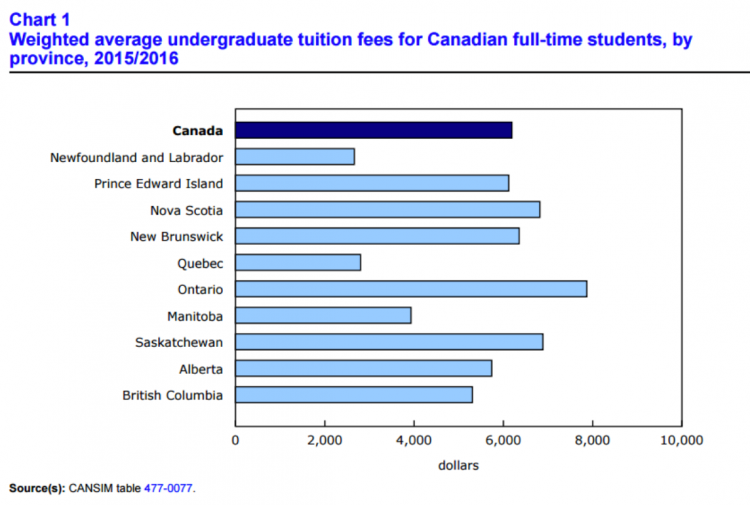Guest blogger: Jasmeet Sandhu
Scholarships, grants, bursaries, and loans are available in all different shapes, prices and size. However, it is vital for students to understand how to seek financial aid. On average, according to Statistics Canada, Canadian citizens studying in Canada are expected to pay CAD $6,000 yearly. On top of that, $600-800 is spent every month on food and other expenses. All together living expenses are between $10,000-$15,000 per year depending on which university students are attending (Collier, 2016).
Without financial aid, it is nearly impossible for students to obtain a university education. In this blog I compare three resources linked from this website: Scholarships Canada, Government of Canada Jobs Training, and Gail’s blog.
Needing assistance is nothing to be ashamed of
As tuition expenses increase, more students are in greater need of financial assistance. Last year, it was recorded that a full time student in the year of 2016 in an undergraduate program on average pays 3.2% more on tuition fees than in the previous year. Also, there was a 3.3% increase in the 2014/2015 year. Nevertheless, the rate of accommodation and other expenses are beginning to slowly increase too. With the increases in expenses it is getting tougher for students to financially support themselves. Students have no choice but to turn to loans, grants, scholarships and budget smarts for support and assistance.
As a student going through the undergraduate school phase is a burden on students. On this website, there are 16 unique centers where students can benefit from. Those are areas with countless links that lead to different websites which are related to the unique center. This is a very essential website for students as it notifies them of information they may have not known existed.
What website will you choose?
The students attending university in the near future can really take advantage of these resources as a great information tool. These resources give out tons of information about grants, loans, scholarships and other budget smarts. The comparison of these resources will help all future students be guided through which resource will work the best.
Comparison Criteria
The criteria I used is based on what information the websites had available for the students, how easy it was to navigate through and find relevant information, if it connected to further links, and whether it seemed trustworthy.
Here is what I think
As you can see from the chart here, Scholarships Canada meets seven out of the eight criteria.While Scholarships Canada does require a login and there is a lot of information to sort through, it offers links to countless scholarships, which allows students to be able to benefit from the financial aid. Wide varieties of scholarships are available for students based on one school or study and others available for any school or study. For some scholarships and bursaries it is so easy to attain, all you have to do is apply.
The second resource I chose was the Canadian government site which offers student grants to help finance post-secondary education. I found this site very reliable as it is a government site, and that it helps not only full-time students but also part-time. However, it does mainly focus on low-income students with dependents, for when they are enrolled in post-secondary institution.
The third resource was a blog focused more on people and on how to save money. This resource was the least effective for students as it focus on the general population being able to save money, and isn’t focusing specifically on the students. However, knowing how to save money is the only way you can spend money. This blog is very valuable to life in general.
My recommendation
After comparing the three resources, Scholarship Canada is the one that is the most effective and useful. This site as of now has 80, 340 awards available worth $174,909,983 that students can easily obtain. It is a site that is a collection place for any money from any source has a lot of potential to help students obtain loans, grants, scholarships and budget smarts.
Out of the three sources Scholarship Canada has the best resources available for all students. It is very clear and straightforward for what you need to be eligible, and it shows deadlines to when a student needs to apply. It is Canada wide, which benefits students because it shows them post-secondary schools they probably did not know existed. There is a search box which helps narrow the search based on what post-secondary institution a particular student would like to go to.
I encourage students to go this site as there are 15 other categories to peruse which will help you with your post-secondary education.
References
Canada Student Grant for Full-Time Students with Dependants. (2016, July 28). Retrieved January 24, 2017, from http://www.esdc.gc.ca/en/student_grants/csg/dependants.page
Collier, S. (2016). How Much Does it Cost to Study in Canada? Retrieved January 24, 2017, from http://www.esdc.gc.ca/en/student_grants/csg/dependants.page
Scholarships Canada. (n.d.). Retrieved January 24, 2017, from http://www.scholarshipscanada.com/index.aspx
University Tuition Fees (2016, September 9). Retrieved January 24, 2017, from http://www.scholarshipscanada.com/index.aspx
Vaz-Oxlade, G. (n.d.). Gail Vaz-Oxlade Make Money Make Sense. Retrieved January 24, 2017, from http://www.scholarshipscanada.com/index.aspx

